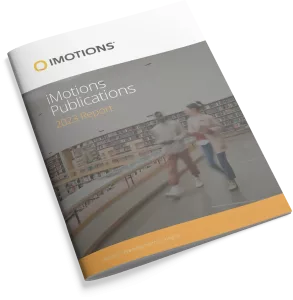-
Measuring Arousal and Emotion in Healthcare Employees Using Novel Devices
A positive working environment is fundamental for reducing employee turnover, and increasing engagement and productivity. Technologies such as wearable sensors and video analysis of facial expressions can be used to objectively measure the emotional responses of employees in real-time in the workplace. The study aims were to perform a preliminary investigation into the validities of […] -
Desired Content versus Digital Advertisements: An Eye-Tracking User Experience Study
Advertisement repetition is known to enhance recall and awareness towards a certain stimulus. However, overexposure is also recognized to negatively impact user experience (UX). Little is understood on how many repetitions are required to achieve a tolerable balance between user experience and advertising. Likewise, the number of displayed advertisements versus seen advertisements is also unclear. […] -
Social attention to activities in children and adults with autism spectrum disorder: effects of context and age
Diminished visual monitoring of faces and activities of others is an early feature of autism spectrum disorder (ASD). It is uncertain whether deficits in activity monitoring, identified using a homogeneous set of stimuli, persist throughout the lifespan in ASD, and thus, whether they could serve as a biological indicator (“biomarker”) of ASD. We investigated differences […] -
Muscle Movements for Non-Invasive Thermal Discomfort Detection via Bio-Sensing Technology
In the time of climate change, as heat waves become a more regular occurrence, indoor thermal comfort is an important factor in day to day life. Due to such circumstances, many researchers have focused their studies on finding an effective solution that will not only enable thermal comfort, but also increase satisfaction within the indoor […] -
The Study of Facial Muscle Movements for Non-Invasive Thermal Discomfort Detection via Bio-Sensing Technology. Part I: Development of the Experimental Design and Description of the Collected Data
In the time of climate change, as heat waves become a more regular occurrence, indoor thermal comfort is an important factor in day to day life. Due to such circumstances, many researchers have focused their studies on finding an effective solution that will not only enable thermal comfort, but also increase satisfaction within the indoor […] -
How online advertising competes with user-generated content in TripAdvisor. A neuroscientific approach
Drawing on cognitive load theory, congruence research, and dual processing models, the purpose of this study is to determine the effectiveness of online advertising in social media. To this end, three separate studies were conducted. First, using eye-tracking and electroencephalography, we examine the differences, based on whether or not an ad is embedded, in subjects’ […] -
Exploring the Relationship between Speech and Skin Conductance for Real-Time Arousal Monitoring
Monitoring human emotions through wearable systems has become an important area of research. Electrodermal activity (EDA) has proven to be a good indicator of emotional arousal, and numerous works have focused on using EDA data to predict emotional states. However, to successfully integrate EDA data into real-time wearable emotion recognition systems, several challenges of practical […] -
How Soundtracks Shape What We See: Analyzing the Influence of Music on Visual Scenes Through Self-Assessment, Eye Tracking, and Pupillometry
This article presents two studies that deepen the theme of how soundtracks shape our interpretation of audiovisuals. Embracing a multivariate perspective, Study 1 (N = 118) demonstrated, through an online between-subjects experiment, that two different music scores (melancholic vs. anxious) deeply affected the interpretations of an unknown movie scene in terms of empathy felt toward […] -
Visual Preference for Biological Motion in Children and Adults with Autism Spectrum Disorder: An Eye-Tracking Study
Participants with autism spectrum disorder (ASD) (n = 121, mean [SD] age: 14.6 [8.0] years) and typically developing (TD) controls (n = 40, 16.4 [13.3] years) were presented with a series of videos representing biological motion on one side of a computer monitor screen and non-biological motion on the other, while their eye movements were recorded. As predicted, participants […] -
Detecting Differences Between Concealed and Unconcealed Emotions Using iMotions EMOTIENT
Biometric analysis is everywhere – even in our cell phone security through facial and fingerprint recognition. It has recently become widely useful in forensic settings as well, being used for facial, fingerprint/palmprint, iris, and voice identification1. Using the iMotions Facial Expression Analysis software, I looked at detection differences between concealed and unconcealed emotions when presented […]
Research Report 2024
In-depth look at the scientific landscape as powered by iMotions software, showcasing groundbreaking research and the impact of our tools in various scientific and industrial fields.

iMotions Science Resources
Looking for white papers, validation reports or research show casing iMotions Multimodal capabilities?
Share Your Research

850+ universities worldwide with an iMotions human behavior lab
73 of the top 100 highest ranked universities
710+ published research papers using iMotions
iMotions is used for some of the most interesting human behavior research studies carried out by top researchers around the world. Contact us to have your publication featured here.
The authors of these publications have used iMotions as a software tool within their research.
“Software should be cited on the same basis as any other research product such as a paper or a book; that is, authors should cite the appropriate set of software products just as they cite the appropriate set of papers” (Katz et al., 2020).
We therefore encourage you to cite the use of iMotions where appropriate.
How to cite iMotions
APA
iMotions (10), iMotions A/S, Copenhagen, Denmark, (2024).
Note: adjust the version and year where relevant.
5 Most Popular Blogs
Publications
Read publications made possible with iMotions
Blog
Get inspired and learn more from our expert content writers
Newsletter
A monthly close up of latest product and research news


